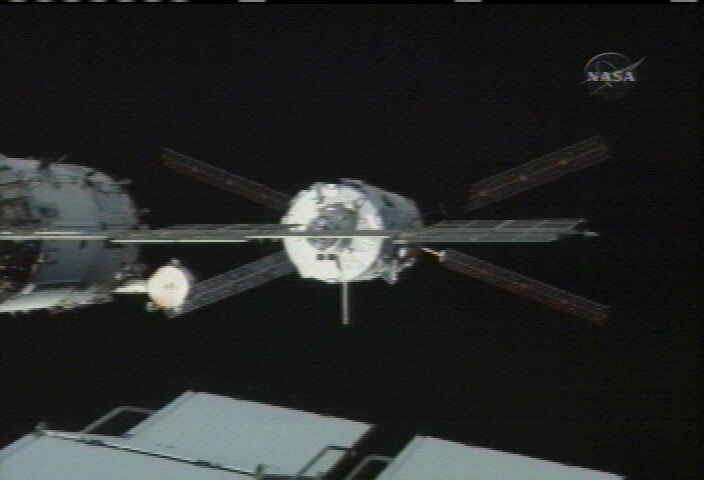European Space Freighter Makes Docking Debut

Thisstory was updated at 4:32 p.m. EDT.
WASHINGTON— Europe?s first space freighter, the unmanned cargo ship Jules Verne, made itsdocking debut at the International Space Station (ISS) Thursday with a gracefularrival after weeks of waiting in Earth orbit.
The firstof a new fleet of automatedresupply ships, Jules Verne successfully docked at the orbiting laboratoryat about 10:40 a.m. EDT (1440 GMT) under the watchful eye of station commanderPeggy Whitson and flight engineer Yuri Malenchenko.
?Right nowthe vehicle can be seen clearly?it?s lit by the sun,? Malenchenko told Russia?sMission Control before thetwo spacecraft docked 212 miles (341 km) above the southern Atlantic Ocean,just south of the equator and east of South America.
Malenchenkowas poised to push a red button on a console inside the station?s Russian-builtZvezda service module that would send Jules Verne away from the ISS should thecargo ship stray off course during its meticulous approach. But thespacecraft?s smooth docking made the emergency measure unnecessary.
Newspaceship class
About thesize of a London double-decker bus, Jules Verne is the first of the ESA?s classof Automated Transfer Vehicle (ATV) spacecraft to fly to the ISS. The agencyspent some 1.3 billion Euros ($1.9 billion) over more than a decade to developand build Jules Verne, and plans to launch as many as seven ATV freightersto resupply the station as payment for astronaut slots on future ISS crews.
Get the Space.com Newsletter
Breaking space news, the latest updates on rocket launches, skywatching events and more!
?It was afirst for Europe and we achieved it on the first try,? said ESA DirectorGeneral Jean-Jacques Dordain during a post-docking webcast. ?I think it?s anincredible technical feat.?
Like all ofESA?s planned ATVs, Jules Verne is a disposable cylindrical spacecraft justover 32 feet (10 meters) long, about 15 feet (4.5 meters) wide and is poweredby four wing-like solar arrays that give it the appearance of a squat dragonflycoasting through space. It is designed to haul up to three times the cargo ofRussia?s unmanned Progress freighters, which deliver 2.5 tons of equipment andsupplies to station during regular shipments.
Tuckedinside the spacecraft?s cargo hold are about 8 tons of supplies, includingfresh food, water, rocket propellant and new equipment for the station?sExpedition 16 crew. Handwrittenmanuscripts by 19th century science fiction writer Jules Verne, after whomESA?s first ATV is named, are also aboard the spacecraft.
Whitson,Malenchenko and ISS flight engineer Garrett Reisman are scheduled to open theJules Verne?s hatch for the first time early Friday at 5:30 a.m. EDT (0930 GMT)to set up air scrubbers, then formally enter the spacecraft over the weekend.The astronauts are expected to begin moving cargo out of Jules Verne earlyMonday, NASA station flight director Brian Smith said after docking.
Jules Verneis the first completely new spacecraft to visit the ISS in nine years,following NASA?s U.S. space shuttles and Russia?s Soyuz and Progress vehicles.But until Thursday?s docking, only Russian spacecraft have flown autonomous missionsto the $100 billion space station.
?Thisaccomplishment showcases yet again the progress which has been made by theinternational partnership in bringing this incredible program to fruition,?NASA chief Michael Griffin said in a statement. ?Together with the arrival ofthe Columbus module at the ISS earlier this year, the success of the ATV marksthe arrival of Europe as a full-fledged space power.?
Astronautsdelivered the European-built Columbus lab during a NASA shuttle mission inFebruary.
Jules Verne?ssuccessful docking automatically frees up more than $350 million in funds forthe ESA use on other space projects, Dordain said in an interview at the agency?sESTEC technology center in Noordwijk, Netherlands, after the rendezvous.
ESA willimmediately have access to the monies that had been withheld, totaling about 240million Euros ($372 million), Dordain said. That money can now be used tosupport the agency?s Columbus laboratory at the ISS, the launch of a second ATVin 2010 and the construction of a third cargo ship.
JulesVerne in space
In additionto its supply function, ATVs will be used to push the nearly 661,386-pound (300,000-kg)space station into a higher orbit, a function that is regularly needed tocompensate for atmospheric drag that pulls the infrastructure into a lowerorbit.
AlbertoNovelli, ESA?s ATV operations manager, told SPACE.com that the JulesVerne ATV will perform the first of several station-reboost maneuvers in April,with several more to follow before the vehicle is filled with garbage, undockedfrom the station and burned up over the South Pacific Ocean as it reenters theatmosphere. NASA ISS managers said Wednesday that they are currently targetingan Aug. 7 undocking for Jules Verne.
Novelliconceded that while the ATV always was confident in the vehicle's capabilities,"we never expected [the docking] would go this smoothly."
The JulesVerne ATV launched March 8 (ET) atop an Ariane 5 rocket from Europe?s SouthAmerican-based spaceport in Kourou, French Guiana to begin four weeks oforbital trials that culminated in two successful rendezvous tests of its videoand laser-based guidance system. A new ATV-only ESA mission control center inToulouse, France, watched over the massive cargo ship?s 26-day inauguralflight.
?We didsome training on this and I?m looking forward to getting yet another module upon station,? Whitson told reporters in a recent interview. ?I think Yuri islooking forward to the challenge of it as well.?
JulesVerne?s successful Thursday docking filled the last open Russian docking portaboard the station, with a Progress cargo ship and Soyuz TMA-11 spacecrafttaking up the other slots. On April 7, the Russian cargo ship Progress 28 willcast off from the station?s Pirs docking compartment to clear a berth for a newSoyuz spacecraft due to ferry the new Expedition 17 crew to the orbiting lab onApril 10, NASA ISS managers said Wednesday.
In aninterview at ESA's ESTEC technology center after the docking, Alan Thirkettle,the agency's space station manager, could not contain his relief.
"Twelveyears after we signed the contract [for ATV], we have now done it,"Thirkettle said. "It was quite an amazing event — a choreographer's dream."
SPACE.comSenior Editor Tariq Malik contributed to this report from Washington, D.C. SpaceNews Staff Writer Peter B. de Selding contributed to this report from theEuropean Space Agency?s ESTEC technology center in Noordwijk, Netherlands.
- NEW VIDEO: Orbital Arrival: Europe's Jules Verne ATV Arrives at ISS
- NEW VIDEO: Europe's Special Delivery to Space Station, ATV Mission Control
- VIDEO: Part 1: Europe's First ISS Cargo Ship, Part 2
Join our Space Forums to keep talking space on the latest missions, night sky and more! And if you have a news tip, correction or comment, let us know at: community@space.com.
Peter B. de Selding is the co-founder and chief editor of SpaceIntelReport.com, a website dedicated to the latest space industry news and developments that launched in 2017. Prior to founding SpaceIntelReport, Peter spent 26 years as the Paris bureau chief for SpaceNews, an industry publication. At SpaceNews, Peter covered the commercial satellite, launch and international space market. He continues that work at SpaceIntelReport. You can follow Peter's latest project on Twitter at @pbdes.









